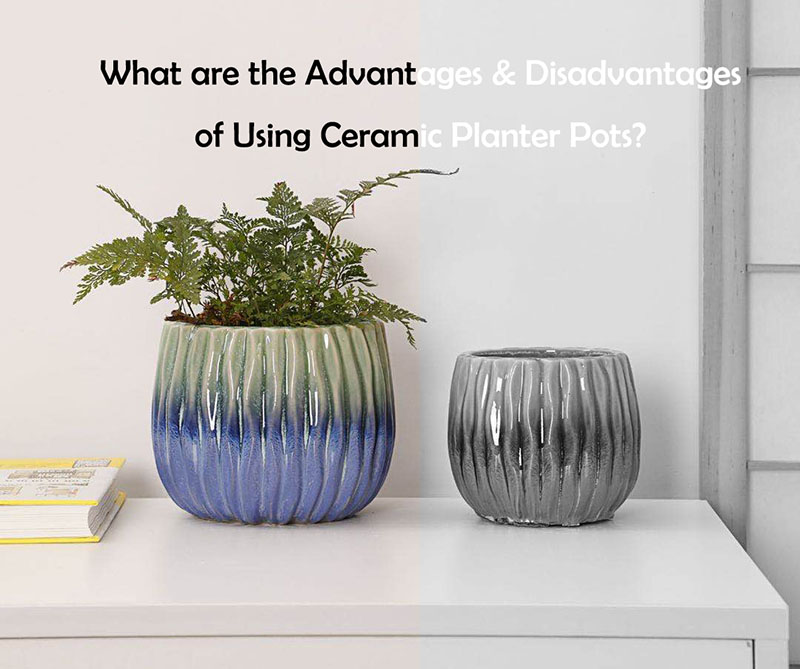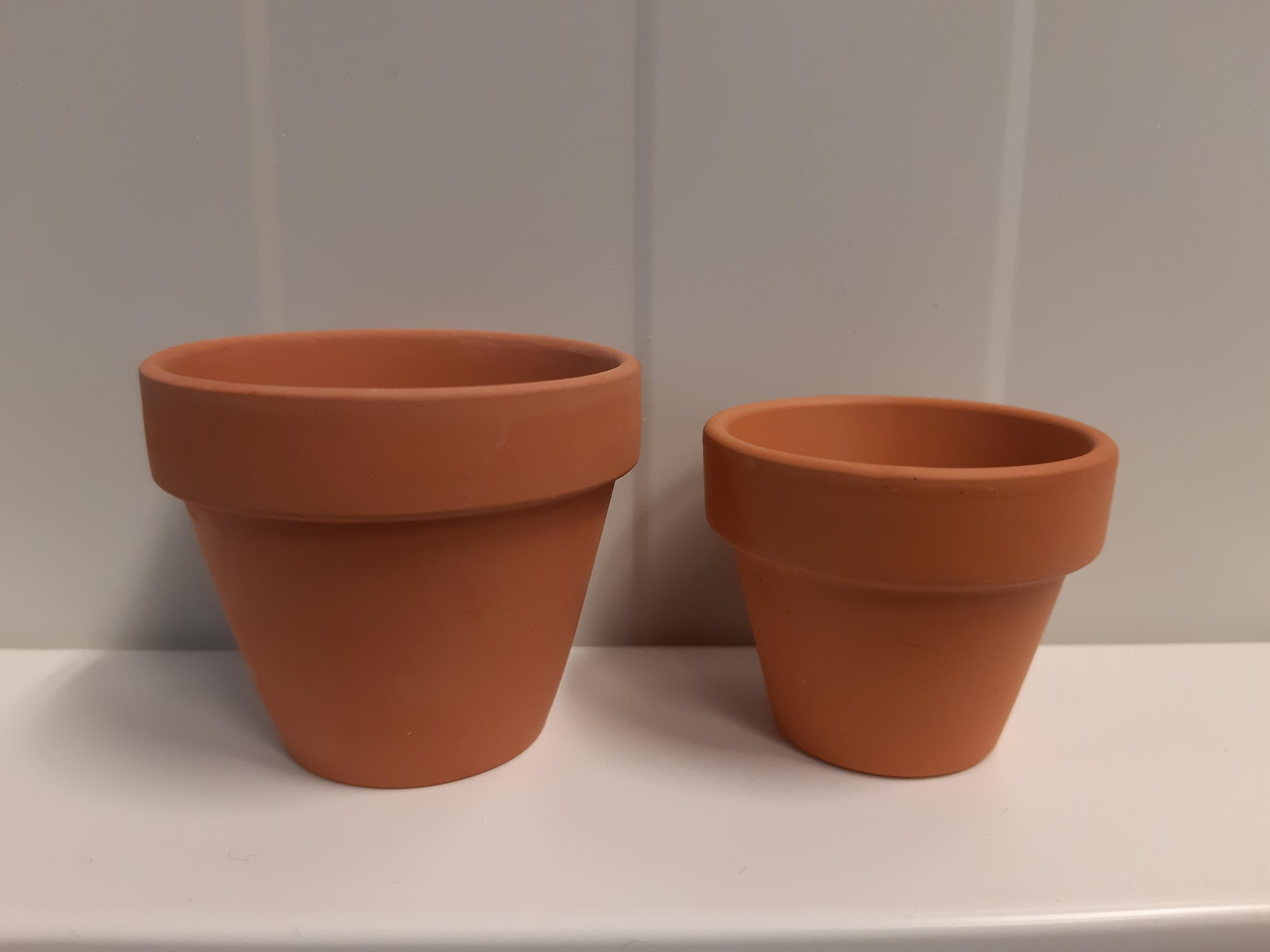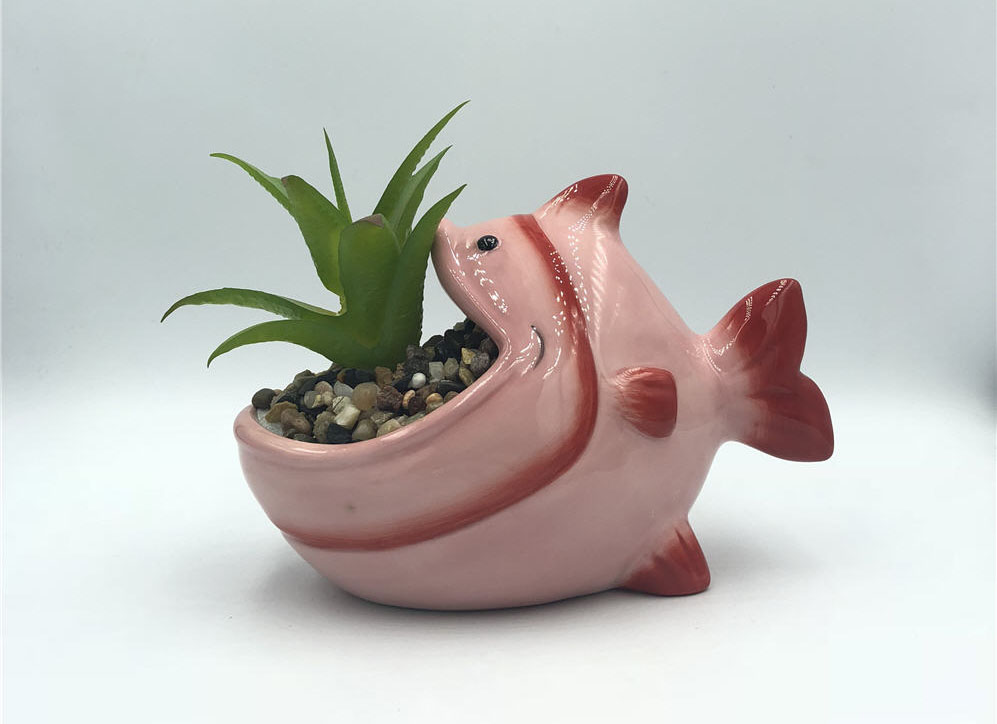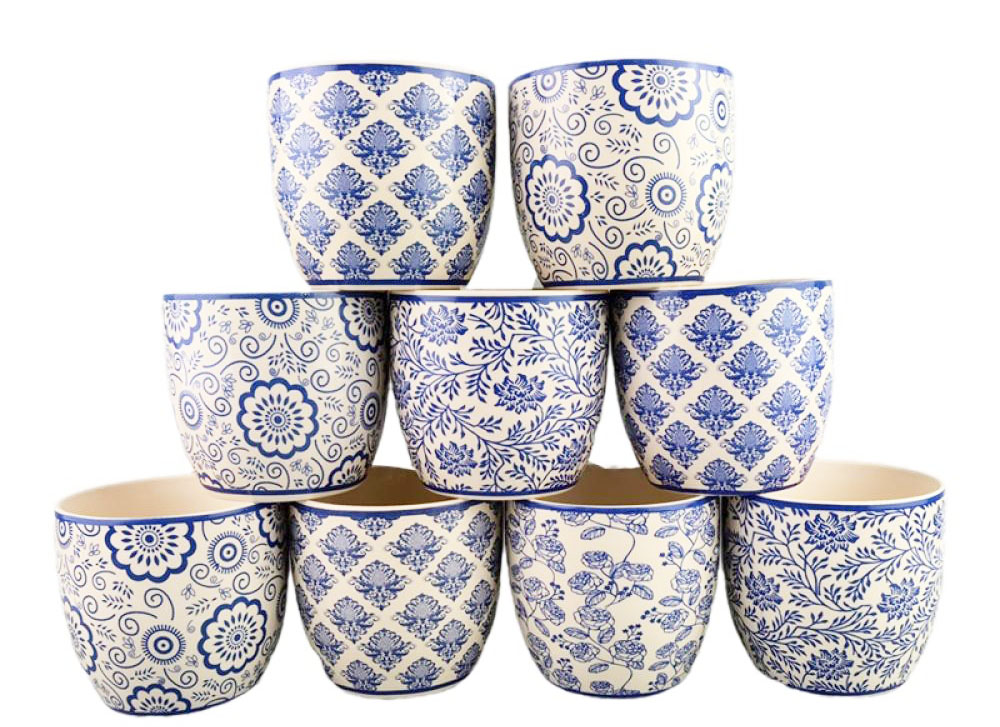What are the Advantages & Disadvantages of Using Ceramic Planter Pots?
Time of issue: 2024-02-18 11:15:33
Gardening enthusiasts often find themselves faced with the delightful task of selecting the perfect planter pots for their green companions. Among the plethora of options available, ceramic planter pots stand out as a timeless choice, cherished for their aesthetic appeal and practicality. In this detailed exploration, we'll delve into the advantages and disadvantages of using ceramic planter pots, helping you make an informed decision for your gardening endeavors.
The Type of Ceramic Planter:
When it comes to adorning your living spaces with the beauty of ceramic flower pots, there's a rich tapestry of options to explore. Ceramic pots come in various materials and styles, each offering its own unique charm and functionality. In this exploration, we'll delve into four popular categories of ceramic flower pots: terracotta flower pot, dolomite succulent planters, stoneware planter, and porcelain plant pot, highlighting their individual characteristics and suitability for different gardening and decor preferences.
Terracotta Flower Pots:

According to LIVINNG COLOR, Terracotta pots are made from natural, porous clay. This porous nature means that moisture is released from the plant pot more quickly, preventing overwatering and soggy soil. For the most part, this is quite advantageous because overwatering is the most common cause of unhealthy or dying plants. However, some plants prefer their soil to be moist all the time, so if you plant them in a terracotta pot, you may have trouble keeping up with watering.
Advantages of Terracotta Planter Pots:
Natural Aesthetic Appeal: One of the most prominent advantages of terracotta planter pots is their natural aesthetic appeal. The earthy tones and textures of unglazed clay evoke a sense of warmth and authenticity, complementing a wide range of plant varieties and garden styles. Terracotta pots blend seamlessly into both indoor and outdoor settings, adding a touch of rustic charm to patios, balconies, gardens, and interior spaces.
Excellent Drainage: Terracotta planter pots are renowned for their porous nature, which allows for excellent drainage of excess water from the soil. This feature helps prevent waterlogging and root rot, ensuring optimal growing conditions for plants. The porous surface of terracotta also promotes airflow to plant roots, preventing the buildup of moisture and reducing the risk of fungal diseases.
Promotes Root Health: The porous nature of terracotta pots not only aids in drainage but also helps regulate soil moisture levels by absorbing excess water from the soil. This promotes healthy root growth by preventing the roots from becoming waterlogged or suffocated. Terracotta pots create an environment conducive to robust root development, leading to stronger and more resilient plants.
Affordability and Accessibility: Terracotta planter pots are widely available at garden centers, nurseries, and home improvement stores, making them accessible to gardeners of all skill levels. Additionally, terracotta pots are generally more affordable than some other types of planters, making them a budget-friendly option for garden projects large and small.
Disadvantages of Terracotta Planter Pots:
Susceptibility to Breakage: Terracotta planter pots are more fragile than pots made from materials such as stoneware planter, porcelain planter. The porous nature of unglazed clay makes terracotta pots susceptible to breakage if dropped or mishandled. Care must be taken when moving or handling terracotta pots to avoid accidental damage.
Prone to Cracking: Terracotta pots are susceptible to cracking, especially in freezing temperatures or when exposed to rapid changes in temperature. Water trapped in the pores of the clay can expand and contract with fluctuations in temperature, leading to cracks or fractures in the pot. Proper winterization techniques, such as bringing terracotta pots indoors during cold weather or providing insulation, can help mitigate this risk.
Requires Regular Watering: Due to their porous nature, terracotta pots tend to dry out more quickly than non-porous containers. This means that plants in terracotta pots may require more frequent watering, especially during hot or dry weather conditions. Gardeners should monitor soil moisture levels closely and adjust watering frequency as needed to prevent plants from drying out.
Stains and Efflorescence: Over time, terracotta pots may develop stains or efflorescence on their surface due to mineral deposits or salts leaching from the clay. While these stains are generally cosmetic and do not affect plant health, they can detract from the appearance of the pots. Regular cleaning with mild soap and water can help remove stains and maintain the aesthetic appeal of terracotta pots.
Dolomite Succulent Planters:

Dolomite succulent planters offer a charming and whimsical option for showcasing succulent plants. These pots are typically made from dolomite ceramic, a type of clay that is known for its smooth texture and vibrant colors. Dolomite planters often feature playful designs, such as animal shapes or intricate patterns, adding a touch of personality to succulent arrangements. With their compact size and excellent drainage, dolomite succulent planters are ideal for creating eye-catching displays on windowsills, tabletops, or shelves.
Advantages of Dolomite Planter Pots:
Charming Aesthetic Appeal: One of the most prominent advantages of dolomite planter pots is their charming aesthetic appeal. Made from dolomite ceramic, these pots often feature playful designs, vibrant colors, and intricate patterns, adding personality and whimsy to any plant display. Dolomite pots are available in a variety of shapes and sizes, allowing for creative and eye-catching arrangements that enhance the visual appeal of indoor and outdoor spaces.
Excellent Drainage: Dolomite planter pots are designed with excellent drainage capabilities, making them ideal for growing succulents, cacti, and other plants that require well-draining soil. The porous nature of dolomite ceramic allows excess water to escape easily, preventing waterlogging and root rot. This ensures optimal growing conditions for plants and promotes healthy root development, even in humid or rainy environments.
Lightweight and Durable: Despite their delicate appearance, dolomite planter pots are lightweight and durable, making them easy to handle and transport. Unlike traditional ceramic pots, which can be heavy and prone to breakage, dolomite pots offer a perfect balance of strength and manageability. This makes them ideal for use on balconies, patios, and windowsills, where space and weight considerations are important.
Disadvantages of Dolomite Planter Pots:
Susceptibility to Breakage: While dolomite planter pots are lightweight and durable, they are still susceptible to breakage if dropped or mishandled. The delicate nature of dolomite ceramic means that care must be taken when moving or repositioning these pots to avoid accidental damage. Additionally, extreme temperature fluctuations can cause dolomite pots to crack or chip, so it's essential to protect them from harsh weather conditions.
Limited Insulation: Dolomite planter pots provide minimal insulation compared to other materials like terracotta or stoneware. This means that plants may be more susceptible to temperature fluctuations in dolomite pots, especially in hot or cold climates. Gardeners should monitor soil temperature and adjust watering and placement as needed to ensure the health and vitality of plants grown in dolomite pots.
Moisture Absorption: While dolomite planter pots offer excellent drainage, they may also absorb moisture from the surrounding environment over time. This can lead to mineral deposits or staining on the surface of the pots, detracting from their aesthetic appeal.
Stoneware Planter Pots:

Stoneware planter pots are prized for their durability and natural elegance. Crafted from high-fired ceramic materials, these pots feature a dense and sturdy finish that can withstand the elements in both indoor and outdoor settings. Stoneware planters often boast rich textures, earthy tones, and subtle variations in glaze, adding a touch of sophistication to any garden or patio. With their strength and resilience, stoneware pots are ideal for showcasing a wide range of plants, from lush foliage to delicate flowers.
Advantages of Stoneware Planter Pots:
Durability and Strength: Stoneware planter pots are prized for their durability and strength, making them ideal for withstanding the rigors of outdoor use. Crafted from high-fired ceramic materials, stoneware pots are less susceptible to cracking, chipping, or fading than pots made from lower-quality ceramics. This ensures that stoneware pots retain their beauty and functionality over time, even when exposed to harsh weather conditions such as freezing temperatures, intense sunlight, or heavy rainfall.
Excellent Insulation: Stoneware planter pots provide excellent insulation for plant roots, helping to regulate soil temperature and moisture levels throughout the year. The dense and sturdy construction of stoneware pots creates a protective barrier that shields plants from temperature extremes, promoting healthier growth and reducing the risk of stress or damage. This makes stoneware pots particularly well-suited for growing a wide range of plants, from delicate flowers to robust shrubs and trees.
Low Maintenance: Stoneware planter pots require minimal maintenance to keep them looking their best. Unlike porous materials such as terracotta, stoneware pots are less prone to absorbing moisture, which reduces the risk of mold, mildew, or staining. Regular cleaning with mild soap and water is usually all that's needed to maintain the beauty and integrity of stoneware pots, making them an easy and hassle-free option for busy gardeners and homeowners.
Disadvantages of Stoneware Planter Pots:
Weight: One of the main disadvantages of stoneware planter pots is their weight. Due to their dense and sturdy construction, stoneware pots can be significantly heavier than pots made from lighter materials such as plastic or fiberglass. This can make them more challenging to move or transport, especially when filled with soil and plants. Gardeners should take this into consideration when selecting stoneware pots for their gardening projects and ensure that they have adequate support or assistance for lifting and maneuvering heavy pots.
Cost Considerations: Stoneware planter pots are often more expensive than pots made from lower-quality ceramics or alternative materials. The high-fired manufacturing process, quality craftsmanship, and durable materials used in stoneware pots contribute to their higher price point. While the initial investment may be higher, many gardeners and homeowners view stoneware pots as worthwhile long-term investments due to their durability, aesthetics, and performance.
Porcelain Planters:

Porcelain planters epitomize luxury and refinement with their delicate beauty and fine craftsmanship. Made from high-quality ceramic materials, porcelain pots feature a smooth and lustrous surface that showcases intricate designs or decorative motifs. These pots are often glazed to enhance their durability and water resistance, making them suitable for both indoor and outdoor use. Porcelain planters add a touch of elegance to any interior or garden space, making them prized possessions for plant enthusiasts and interior designers alike.
Advantages of Porcelain Planter Pots:
Exquisite Beauty: One of the most prominent advantages of porcelain planter pots is their exquisite beauty. Made from high-quality ceramic materials, these pots boast a smooth and lustrous surface that showcases intricate designs, patterns, or decorative motifs. Porcelain pots are available in a wide range of styles, from classic and traditional to modern and contemporary, allowing homeowners to find options that complement their decor preferences and personal taste.
Exceptional Durability: Porcelain planter pots are prized for their exceptional durability and strength. Unlike pots made from lower-quality ceramics, porcelain pots are fired at high temperatures, resulting in a dense and sturdy finish that can withstand the elements in both indoor and outdoor settings. Porcelain pots are less susceptible to cracking, chipping, or fading over time, ensuring that they retain their beauty and functionality for years to come.
Water Resistance: Porcelain planter pots are naturally water-resistant, making them ideal for use with a wide range of plant varieties. The smooth and non-porous surface of porcelain pots prevents water from seeping through the walls of the pot, reducing the risk of water damage to furniture, floors, or surfaces. This makes porcelain pots particularly well-suited for indoor use, where water spills or leaks are a concern.
Low Maintenance: Porcelain planter pots require minimal maintenance to keep them looking their best. Unlike porous materials such as terracotta, porcelain pots are less prone to absorbing moisture, which reduces the risk of mold, mildew, or staining.
Disadvantages of Porcelain Planter Pots:
Fragility: One of the main disadvantages of porcelain planter pots is their fragility. While porcelain pots are durable and resistant to cracking or chipping under normal use, they can still be damaged if dropped or mishandled. Care must be taken when moving or repositioning porcelain pots to avoid accidental breakage, especially when dealing with larger or heavier pots.
Cost Considerations: Porcelain planter pots are often more expensive than pots made from lower-quality ceramics or alternative materials. The high-fired manufacturing process, quality craftsmanship, and durable materials used in porcelain pots contribute to their higher price point. While the initial investment may be higher, many gardeners and homeowners view porcelain pots as worthwhile long-term investments due to their beauty, durability, and performance.
Conclusion
In conclusion, ceramic flower pots offer a diverse array of options to suit every taste and decor preference. Whether you're drawn to the rustic charm of terracotta, the whimsical appeal of dolomite succulent planters, the natural elegance of stoneware, or the luxurious beauty of porcelain, there's a ceramic planter pot to complement your unique style. By understanding the distinctive characteristics of each type of ceramic pot, you can select the perfect vessels to showcase your favorite plants and enhance the beauty of your living spaces
RECENT POSTS
- The Benefits of Wholesale High-Quality Ceramic Products for Retailers
2025-12-17
- Can You Make an Ashtray with Air Dry Clay? Pros, Cons, and Safer Alternatives
2025-12-17
- The Impact of Ceramic Materials in Energy-Efficient Buildings: Benefits and Applications
2025-12-04
- Top 7 Ceramic Cookware Health Benefits: Why It’s a Safer Choice for Your Kitchen
2025-12-04
- How to Clean Ceramic Planters and Improve Their Lifespan?
2025-11-17
- 15 Best Ceramic Holiday Gift Ideas for 2025: Thoughtful, Elegant & Heartfelt
2025-11-17
- Stoneware vs Porcelain vs Earthenware: Quick Decision Guide
2025-10-09
- Are Ceramic Glazes Food Safe? The Truth Behind the Shine
2025-10-09










